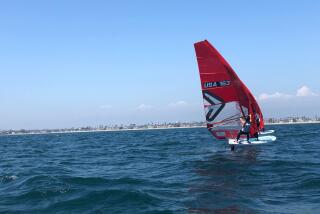Jayhawk Flies to Win in Cup Championship : Sailing: Victory doesn’t keep Koch from disliking the new boats, however.
- Share via
SAN DIEGO — Bill Koch’s boat is one he loves to hate. He has described all of the new America’s Cup boats as “incredibly dangerous,” but he also dubbed his new boat “Jayhawk,” for his native Kansas.
“A Jayhawk is a mythical bird that’s very fast,” Koch explained.
The boat was built secretly at Hercules Aerospace in Utah and, after only five days of shakedown sailing, the way it struggled in the first week of its first competitive tests left observers wondering whether it was a mythical bird or a mythical boat. It certainly wasn’t a rocket ship.
Then, in tricky 7- to 11-knot winds Monday, Koch came from nowhere to pass Chris Dickson’s Nippon Challenge and Rod Davis’ New Zealand on the last two legs to win the third race of the International America’s Cup Class World Championship by 51.9 seconds.
Following an earlier dropout and a sixth place, that lifted Koch to fifth place behind Dennis Conner’s Stars & Stripes in the fight for the four semifinal berths. New Zealand leads, with two fleet races remaining.
Tom Whidden, Conner’s tactician, said, “The way the Kiwis are looking, it’s lucky we had a catamaran last time.”
Koch, a multi-millionaire industrialist, was among the first to complain about the flimsy construction of the new boats. He predicted masts would fall down. Masts fell down.
Last weekend, after a series of breakdowns in Race One, Koch reiterated, “What worries us is that the structure of the deck may fall apart or give away. The hulls would probably shatter like glass if a couple of the boats ran into each other.”
The words were supported by three engineering degrees from MIT, but Dickson suggested that perhaps an “average” sailor couldn’t handle an IACC boat, no more than Dickson could a Formula One race car.
Koch responded, “I hope I get a chance to compete with Chris Dickson. It’d be fun.”
Koch had an ace to play: John Kostecki.
Kostecki is not an average sailor. He is a world Soling and J-24 champion and an Olympic silver medalist, and he was on board Koch’s boat Monday, sharing the helm, after sailing the team’s slower USA-2 with Buddy Melges the first few days.
Tactician Gary Jobson has been steering Jayhawk for the starts, then turning the helm over to Koch. Kostecki steered for the two downwind legs Monday.
Jayhawk passed Dickson on the last upwind leg and New Zealand on the downwind finishing leg--another new wrinkle for the ’92 Cup. With Kostecki steering and the boat carrying a larger spinnaker than New Zealand, they made the most of more favorable wind.
Koch said afterward, “I still think the rule is a foolish one. I don’t think these boats are grand prix boats. In heavy winds they are dangerous and brittle and very expensive and they do not go as fast or point as well as other sailboats of equivalent size.”
Conner and Il Moro di Venezia’s Paul Cayard sailed themselves out of the race early--Conner by going northwest as the wind shifted 30 degrees southwest, Cayard by jumping the gun and having to re-start late, along with Ville de Paris and Spain ’92.
Conner got back to fourth but Cayard struggled home seventh. The sailors expect more scrambling before the week is out.
“It’s a real challenge sailing these waters,” Jobson said, “because the wind is not only shifty but it goes up and down a lot.”
Whidden added, “San Diego is a unique place. For the amount of wind there is out there there’s an awfully rough sea. It’s the swell off the Pacific and the chop that builds up inside the swell. I don’t think the maxis would be tacking be through lot narrower angles in these light winds and rough conditions.”
There was a rumor that somebody on Stars & Stripes fell overboard near the end of the race, but Whidden denied it.
“A lot of you people probably thought that was me jumping overboard after calling tactics on the first leg,” he told reporters.
Another Stars & Stripes rumor was that even if he qualified, Conner wouldn’t sail in the semifinals, to save his boat.
“I can honestly say that thought has entered our minds,” Whidden said. “But we even thought about not going in the worlds and (if we did) about not finishing each race. I guess the adrenaline gets going and you try to do a little better every day. I think we’ll play each day by ear.”
New Zealand has done best on light-air days, but Davis isn’t convinced the boats are less competitive in strong winds.
“We don’t think of our boats as light-air boats,” he said. “We didn’t set up (with proper sails) for those two (windy) days. I’d like to see it blow harder just to see.”
There also is a suspicion that the Kiwis aren’t sailing the fastest of their three boats. All were designed by Bruce Farr but two were built by Marten Marine in Auckland, the other by Cookson Boats.
More to Read
Go beyond the scoreboard
Get the latest on L.A.'s teams in the daily Sports Report newsletter.
You may occasionally receive promotional content from the Los Angeles Times.










